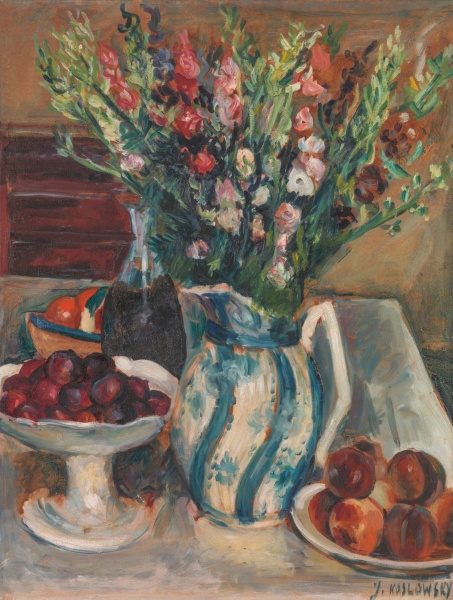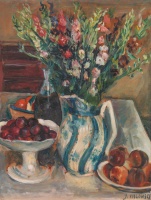
Still-Life with Plums, Peaches and Flowers in a Vase
| Author: |
Jokūbas Koslowsky (1904–1993)  |
| Created: | second half of the 20th century |
| Material: | cardboard |
| Technique: | oil |
| Dimensions: | 59 × 45 cm |
| Signature: | bottom right: J. KOSLOWSKY |
Jacques Koslowsky (1904–1993) trained in Kaunas and Paris, but spent the second half of his life in Mallorca, where this collection of objects must have been painted. Arrangements of similar objects recur in several of his still-lifes, in which we recognise the high white bowl, with plums, apricots and peaches, a simple faience plate for fruit, and, of course, the most prominent element, a blue-andwhite striped vase with a rich and colourful bunch of flowers. According to Vilma Gradinskaitė’s Litvak Art (2015), there are at least three still-lifes by Koslowsky depicting the same striped blue vase in private collections in Lithuania alone (pp. 99, 102, 103). The picture owned by Edmondas Kelmickas (p. 102, cat. 125) combines a still-life and an interior, and therefore opens up the artist’s room, allowing us a glimpse of a table with frequently painted objects on it, a heavy Neo-Renaissance chair by the table, and a chest of drawers standing against the wall.
Text author Giedrė Jankevičiūtė
Time and cyclicity. The Jews count time from the beginning of the creation of the world rather than from the birth of Christ, so they add 3,761 years to the Gregorian calendar used by the Western world. They follow the lunar calendar, and count the beginning of the day from the sunset, because then evening is mentioned first in the Torah: ‘And God called the light Day, and the darkness he called Night. And there was evening, and there was morning the first day’ (Genesis 1:5). There are 354 or 355 days in a lunar year, that is, ten or 11 days fewer than in the Gregorian solar year of 365 days. Jewish holidays are closely related to the cycle of nature: Pesach is the time of spring, Shavuot is the grain harvest time, and Sukkot the harvest time. Therefore, if there is any risk of violating the cyclicity of the year, a 13th month is added to the calendar.
In all Ancient cultures, the cyclicity of nature plays a special role in understanding the fullness, perfection and completeness of the world. The indestructible cyclicity of the Universe is strongly present in the work of Jacques Koslowsky. The artist was fond of painting still-lifes, in which he kept rearranging the same objects. Looking at several hundred of his still-lifes, we can observe the passage of time, how flowers in a vase wither, fruit ripens and rots, a decanter is filled with red wine and then becomes empty, a woman in a white dress enters a room, sits next to the still-life, eats the fruit, sips the wine, reads a book, and leaves again.
Text author Vilma Gradinskaitė
Source: Law firm Valiunas Ellex art album OBJECTS ON SHOW (2017). Compiler and author Giedrė Jankevičiūtė, STORIES OF LITVAK ART (2023). Compiler and author Vilma Gradinskaitė






